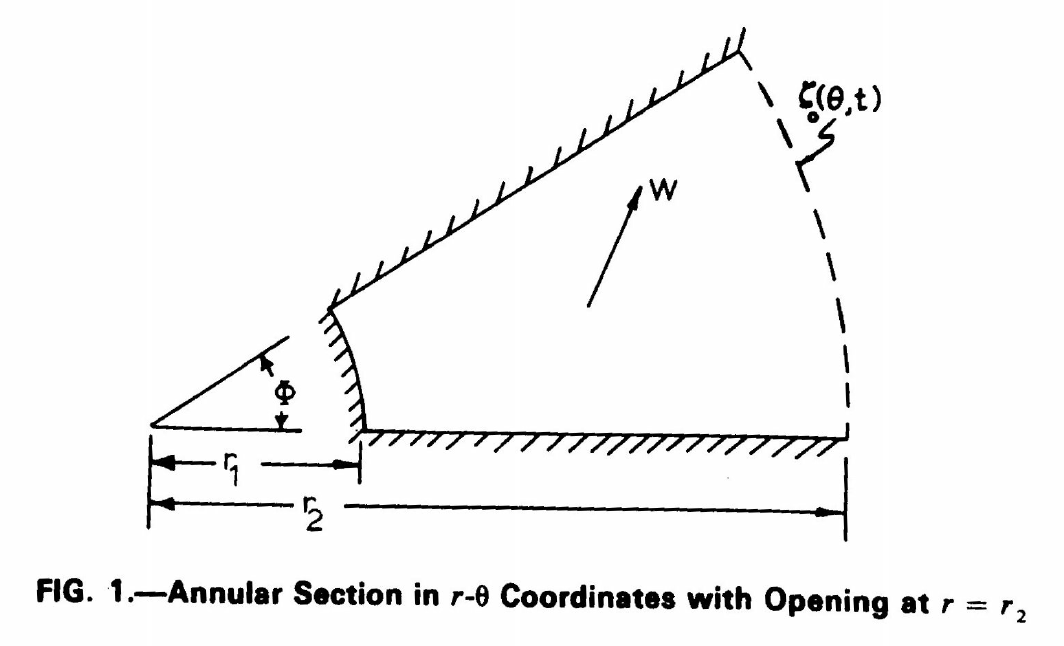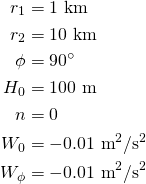However, we found an error in their solution for wind-driven setup on a polar domain. It appears to be a typographical error — the variables are not updated correctly at the last step, when the solution is generalized for a wind with arbitrary direction. This solution is not used frequently, and we did not find a correction to this error in the literature (although we were unable to access every subsequent manuscript that cited the Lynch and Gray solution). So we are documenting it here.
Basic Equations
To derive an analytical solution, Lynch and Gray start with the linearized shallow water equations:
![]()
and:
![]()
in which ![]() is the water level relative to mean sea level,
is the water level relative to mean sea level, ![]() is the depth averaged velocity,
is the depth averaged velocity, ![]() is the bathymetric depth,
is the bathymetric depth, ![]() is gravity,
is gravity, ![]() is a linear bottom friction, and
is a linear bottom friction, and ![]() is the constant wind stress (with units of
is the constant wind stress (with units of ![]() ).
).
These equations are combined into a single wave equation:
![]()
which is then solved for the water level, ![]() . For the no-tides solution
. For the no-tides solution ![]() , they assume steady flow and thus the friction can be ignored.
, they assume steady flow and thus the friction can be ignored.
Wind Forcing on Polar Domain
We are interested in their solution for wind-driven flows on a polar domain, as shown below. Flow is required to be tangential to the solid boundaries at ![]() ,
, ![]() , and
, and ![]() , where
, where ![]() is arbitrary. For the wind-only case, the water levels are pinned at the outer boundary,
is arbitrary. For the wind-only case, the water levels are pinned at the outer boundary, ![]() . A constant wind stress
. A constant wind stress ![]() is applied in an arbitrary direction. Bathymetry is described by
is applied in an arbitrary direction. Bathymetry is described by ![]() , in which
, in which ![]() is constant and
is constant and ![]() may assume any real value.
may assume any real value.

Original Solution
A boundary-value problem is defined on this polar domain, and then a solution is derived by using separation of variables, an assumed form, and a Fourier series. The solution is drived fully for a wind stress acting in the ![]() direction (i.e. toward the right in the figure), but then the solution is generalized for a wind stress with arbitrary direction:
direction (i.e. toward the right in the figure), but then the solution is generalized for a wind stress with arbitrary direction:
![]()
in which ![]() and
and ![]() are the wind stress components in the
are the wind stress components in the ![]() and
and ![]() directions. (For example, if
directions. (For example, if ![]() , then
, then ![]() would act toward the top in the figure.) With this setup, they derive the analytic solution:
would act toward the top in the figure.) With this setup, they derive the analytic solution:
![Rendered by QuickLaTeX.com \begin{equation*} \begin{aligned} \zeta_W \left( r , \theta \right) &= a^* r^{1-n} \left\{ W_0 \cos \left[ \kappa^* \theta \right] + W_\phi \cos \left[ \kappa^* \left( \theta - \phi \right) \right] \right\} \\ ~ &+ \sum_{j=0}^{\infty} \left\{ a_j r^{s_j} + b_j r^{t_j} \right\} \left\{ W_0 \cos \left( \frac{ j \pi \theta }{ \phi } \right) + W_\phi \cos \left[ \frac{ j \pi \left( \theta - \phi \right) }{ \phi } \right] \right\} \\ \end{aligned} \end{equation*}](https://ccht.ccee.ncsu.edu/wp-content/ql-cache/quicklatex.com-0570333101e5160fd018b2eff60d328b_l3.png)
in which the coefficients ![]() are defined in their paper (linked above). For example, the first coefficient is:
are defined in their paper (linked above). For example, the first coefficient is:
![]()
However, this solution is incorrect because it does not fully account for the arbitrary direction in these coefficients, which were derived only for the direction ![]() . To account correctly for the additional component in the direction
. To account correctly for the additional component in the direction ![]() , the coefficients need to be re-defined, and the solution needs to be re-written.
, the coefficients need to be re-defined, and the solution needs to be re-written.
Corrected Solution
That first coefficient should be:
![]()
in which the numerator is now a function of direction ![]() , and
, and ![]() can be either
can be either ![]() (for
(for ![]() ) or
) or ![]() (for
(for ![]() ). This correction must be carried through the other coefficients
). This correction must be carried through the other coefficients ![]() and
and ![]() .
.
The correct analytical solution should be:

which accounts correctly for the contributions to the water levels from the two wind stress components. With this corrected solution, the water levels should respond correctly inside this polar domain.
Example
We considered a simple test case with the following parameters:

so the domain is a quarter annular harbor with a constant bathymetry, and the wind stress is acting toward the bottom left. The water levels show a setup in the lower-left of the domain, with peaks of about 12 cm:

References

